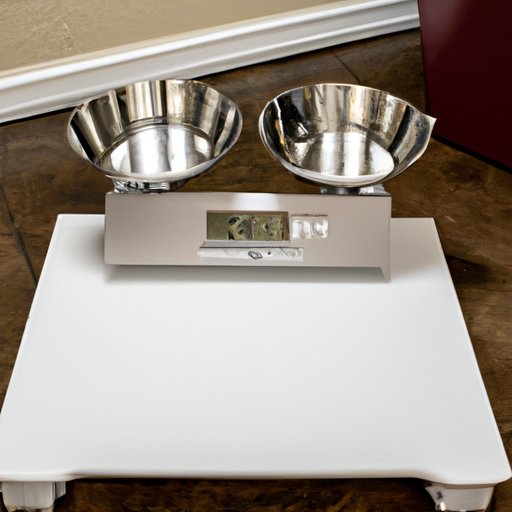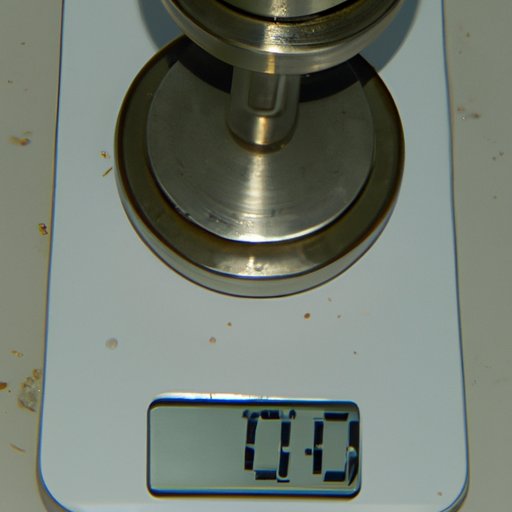Introduction
Scales are an essential tool in many industries, from medical and scientific research to retail and food production. In order to accurately measure weight or mass, it is important to understand how a scale works. This article will provide a comprehensive look at the different types of scales, how they operate, and the science and physics behind weighing objects.

Exploring the Mechanics of a Scale: A Guide to Understanding How Scales Work
In order to understand how a scale works, it is important to first have a basic understanding of the different types of scales and their functions. The three main types of scales are spring scales, beam scales, and electronic scales. Spring scales use a spring to measure weight, while beam scales use a lever arm and a fulcrum to measure weight. Electronic scales measure weight using force transducers, which convert force into an electrical signal that can be measured and displayed.
Once you have a basic understanding of the different types of scales and their functions, it is important to explore the physics behind weighing objects. When an object is placed on a scale, the scale measures its mass by balancing the force of gravity against the force of the spring, lever arm, or force transducer. This process is known as equilibrium, and it is the basis for all scales. The heavier the object, the more force is needed to balance the forces and keep the scale in equilibrium.
The next step in understanding how a scale works is to analyze the components of a scale and how they function together. All scales consist of two main components: a load cell and a display. The load cell is responsible for measuring the force applied to the scale, while the display is used to show the measured weight. These components work together to accurately measure the weight of an object.
The Science Behind a Scale: An Overview of the Technology and Physics Involved in Weighing Objects
Once you have a basic understanding of the mechanics of a scale and how the components of a scale work together, it is important to explore the science behind a scale. Scales use a variety of different technologies to measure weight, such as strain gauges, force transducers, and load cells. Strain gauges measure the strain on the scale caused by the force of gravity, while force transducers and load cells measure the force applied to the scale.
The physics behind weighing objects is also an important part of understanding how a scale works. When an object is placed on a scale, the force of gravity is balanced against the force of the spring, lever arm, or force transducer. This process is known as equilibrium, and it is the basis for all scales. The heavier the object, the more force is needed to balance the forces and keep the scale in equilibrium.

Scale of Measurement: A Comprehensive Look at the Different Types of Scales and How They Operate
When it comes to understanding how a scale works, it is important to have a comprehensive look at the different types of scales and how they operate. The three main types of scales are spring scales, beam scales, and electronic scales. Spring scales use a spring to measure weight, while beam scales use a lever arm and a fulcrum to measure weight. Electronic scales measure weight using force transducers, which convert force into an electrical signal that can be measured and displayed.
It is also important to examine the advantages and disadvantages of each type of scale. Spring scales are relatively inexpensive, but they are not very accurate and can be affected by temperature changes. Beam scales are more accurate than spring scales, but they can be difficult to use and require frequent calibration. Electronic scales are the most accurate, but they are also the most expensive and require regular maintenance.
The Basics of Balance: A Step-by-Step Guide to Understanding How a Scale Works
Once you have a basic understanding of the different types of scales and how they operate, it is important to explore the basics of balance and how a scale works. Balancing is the process of evenly distributing the weight of an object across the surface of the scale. This is done by adjusting the position of the fulcrum, lever arm, or force transducer until the scale is in equilibrium.
There are several different methods of balancing a scale, including the use of weights, counterweights, and levers. Weights and counterweights can be used to adjust the position of the fulcrum, lever arm, or force transducer until the scale is in equilibrium. Lever arms can also be used to adjust the position of the fulcrum or force transducer until the scale is in equilibrium.

Weight Matters: Examining the Components of a Scale and How They Function Together
Understanding how a scale works also involves analyzing the different parts of a scale and how they function together. All scales consist of two main components: a load cell and a display. The load cell is responsible for measuring the force applied to the scale, while the display is used to show the measured weight. These components work together to accurately measure the weight of an object.
Scales also consist of several other components, such as a frame, springs, levers, and force transducers. The frame provides structural support for the scale, while the springs, levers, and force transducers are responsible for measuring the force applied to the scale. All of these components work together to accurately measure the weight of an object.
Conclusion
Scales are an essential tool in many industries, from medical and scientific research to retail and food production. In order to accurately measure weight or mass, it is important to understand how a scale works. This article has provided a comprehensive look at the different types of scales, how they operate, and the science and physics behind weighing objects. It is important to understand the components of a scale and how they function together, as well as the different technologies and methods used in scales. By understanding how a scale works, you can ensure that your measurements are accurate and reliable.
(Note: Is this article not meeting your expectations? Do you have knowledge or insights to share? Unlock new opportunities and expand your reach by joining our authors team. Click Registration to join us and share your expertise with our readers.)
